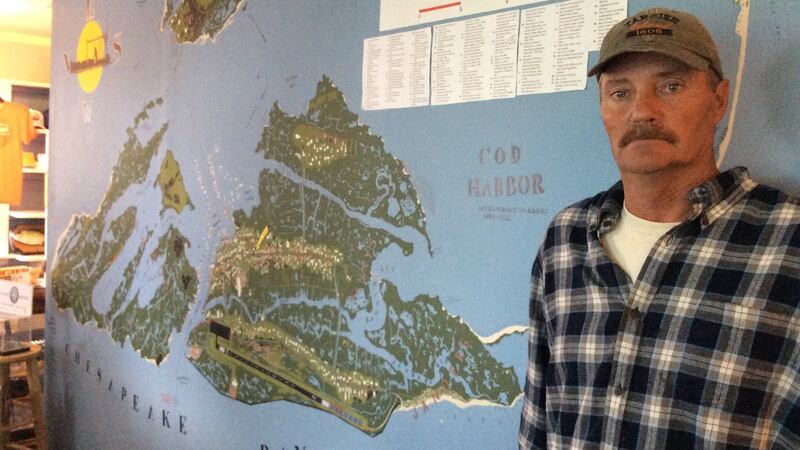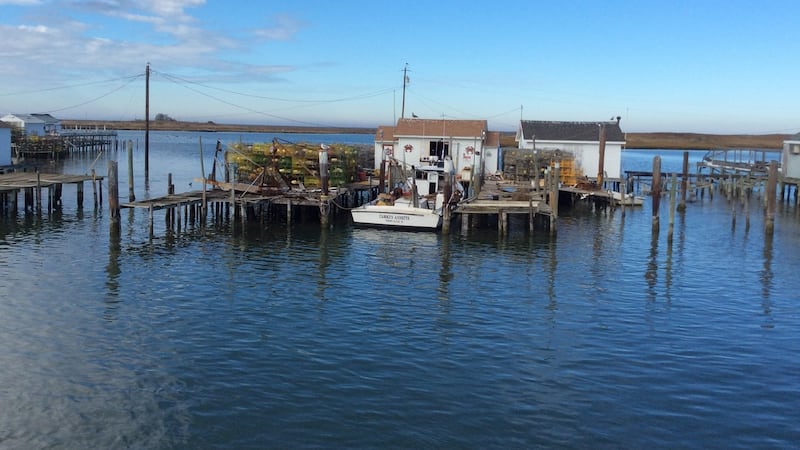As James “Ooker” Eskridge drives around Tangier Island, which he has represented as mayor for eight years, he stops his electric golf cart next to the New England-style white clapboard houses stacked up against each other.
This small community, comprising about 450 people, used to bury their dead in cemeteries but one graveyard in the northern part of the island, in an area called Uppards, was washed away by the bay’s high tides and strong winds.
The island stands at just 4ft above sea level so it is vulnerable to the vast expanse of water around it, Chesapeake Bay, the largest estuary in the US.


Now families on the island are burying loved ones in their front gardens again. “We are running out of land for the living and the dead,” says Eskridge.
Tangier, measuring just 4km by 1½km, lies 19km out in the Chesapeake, which links the Atlantic Ocean with the port city of Baltimore in Maryland and, via the Potomac river in Washington DC.
English explorer Capt John Smith discovered the island in 1608 but it wasn't inhabited until the late 18th century. The island's newest gravestones still bear the names of the first settlers who came from England: Crockett, Parke and Pruitt.
“My husband said when he passes away, no matter what, bury him on Tangier, bury him under the house,” says Carol Moore, who was born here 53 years ago.
Future generations may not be able to live on the island, never mind being buried on it. Tangier is being washed away, by a combination of sinking land, high tides and winds, and rising sea levels as a result of the world’s changing climate.
For the climate change doubters in Washington’s corridors of power, the island is a very close example of the planet’s race against time. It is just 90 miles from the US capital as the crow flies.
The United States Geological Service (USGS) said in a 2013 report that the southern Chesapeake Bay region is experiencing "the highest rates of sea-level rise on the Atlantic coast of the United States."
The pumping of groundwater on the mainland is compacting aquifers and leading the land to subside. This combined with rising sea levels is resulting in "a relative sea-level rise" of between 3½-5mm a year, according to Jack Eggleston, a hydrologist with the USGS and a co-author of the report.
“It is a gradual thing but as the years go by, that change stacks up and it makes a difference,” he says.
A 2012 report on climate change in the Hampton Roads, an area of towns and water in the southern Chesapeake, commissioned to prepare the area for the decades ahead, found that given the region was experiencing sea-level rise at a rate greater than the current global average, a one-metre scenario of local sea level rise by the year 2100 is “both plausible and defensible.”
A 2014 report by the National Oceanic and Atmospheric Administration found that Annapolis and Baltimore, Maryland – further up the Chesapeake – had the highest increases in the number of "nuisance flood days" of 45 locations analysed across the US – more than 920 per cent – since 1960.
All this does not bode well for Tangier.
“If a large hurricane came straight up the bay, you would not want to be on Tangier Island,” says Eggleston. The concern is that unless a large sea wall is built around the island, all that will remain is the island’s big water tower.
“There is a definite thought that the island is in danger,” says Eggleston.
Tidal canals
Eskridge, pointing to the tidal canals in the marshlands between the island’s ridges, says that during a storm about 75 per cent of the island will go under water. The mayor doesn’t see climate change as the problem.
Tangier has been losing land for centuries, he says – the island was three times the size it is now back in 1608.
“The erosion that is going on, it has been going on since Capt John Smith sailed here,” he said.
“We had a lot of land to give up at the time but when the erosion gets to your doorstep, you pay more attention to it. I don’t believe it is increasing. It is just getting so close now that we don’t really have a lot of time to play with.”
Tangier lost several communities on its edge in the 20th century. The island was losing 25-30ft a year on the west side of the island until a sea wall was built in 1989. “We haven’t lost one inch since then,” says Eskridge.
Work will start on 2017 on adding to that wall. The problem now is the north and eastern parts of the island where the tide and winds is washing away more of the island, between 20-25ft a year in storms that blow north called "Nor'easters" or tropical storms that blow up from the US Gulf of Mexico.
This exposes the island’s open harbour, a workplace for between 100 and 150 “watermen” – the blue crab and oyster fisherman who sustain the island.
Erosion documented
Carol Moore documents the erosion in Uppards with photography. In the past year, she says she has seen 50-75ft wash away on the island’s northside and close to 15-20ft from one week to the next during a recent storm.
“I could not believe the change. I was in awe,” she says.
“My fear is that because of the delay in having it [a sea wall around the island] it is a day late and a dollar short. If something isn’t done, Tangier is history.”
Most older residents agree with Eskridge in his doubts about climate change. They see the island’s problems as a generations-old loss of land through erosion.
Cornish
Next to the island’s power generator, a group of old men discuss the issue in a meeting room where they talk in accents that still have strong hints of Cornish. A car tyre is pronounced “tower,” tide is “towied” and tourists sounds like “terrorists”.
“I’ve been here 72 years and I don’t see no difference. We have our high tide in the spring and in the fall, just like we did when I was a boy,” says George Cannon.
“I just think lots of people get rich with it,” said one of the men, regarding those campaigning to raise awareness about climate change, naming former US vice-president Al Gore.
Another of the men, Bruce Gordy (75), said he believed the science around climate change, but his main concern was the much more immediate one of erosion of their small island.
Although in the growing purple state of Virginia, Tangier is dark red. About 90 per cent of people on the island vote Republican, says Eskridge. It is conservative and Christian. Businessman Donald Trump, retired surgeon Ben Carson and Texas senator Ted Cruz are the most popular Republican candidates on the island.
The debate around climate change is certainly political. US president Barack Obama has made tackling climate change a key priority in his remaining 14 months in the White House. Democrats ridicule the sceptics who refuse to accept the human cause and effect on climate change because they are "not scientists".
Obama’s secretary of state, John Kerry, in a speech last week at a university in Norfolk, Virginia – in the Hampton Roads area – warned about the threat of climate change to national security, pointing out that the region is home to Norfolk naval station, the biggest naval station in the world.
“The land it is built on is literally sinking,” he says. “Local sea levels are rising twice as fast as the global average. The waters have already crept up a foot and a half since the 1920s. The streets now flood when there’s a rainstorm at high tide.”
Eskridge says that the islanders have seen abnormally low tides with areas “that have never been out of the water before”, while they have never seen a sea as high as a 1933 storm that left a boat washed up in front of the island’s grocery store.
The men say that they are not worried about where sea levels might be 100 years from now; the islanders are worried about the coming decade or two.
“It is irrelevant to us,” says Gordon. “We are worried about washing away in the next 20 years. All this long-term stuff, to me it is irrelevant. Why am I worried about sea-level rising when we have just a few years down the road?”
Carol Moore, sitting in her golf cart, says she is not naive to think that sea levels are not rising. “Is it affecting Tangier? I don’t know,” she says.
She contemplates an uncertain future on Tangier for her grandchildren.
“There may be people living here in the next 50 years. I doubt it. I truly doubt it,” she says.
“I would think that at some point in my grandchildren’s lives, they will have to relocate.”









